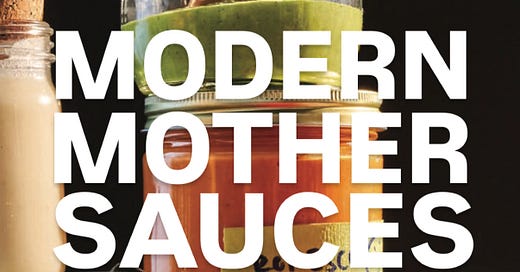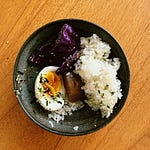Beloved California, beautiful Los Angeles and its beautiful people. They are on the front line of climate change and we owe them so much. On January 25th Archestratus Books & Foods is hosting a bake sale to benefit rebuilding efforts. I’ll be baking something very California, currently looking through my Tassajara cookbooks. NYC please come out and support, let’s show them all the love.
Last week we spoke on the elements of a dish, a topic so important that one half of Bright Cooking is dedicated to it. At their core, all dishes can be broken down in the following way: the star, the sauce and the flourish. Consider flourishes as the supporting cast of your plate but also the element that sets the dish apart, a visual and delicious bit of a salty, bright, spicy, or crunchy. Learning these various components can bring ease and have you cooking from a place of creativity and craving. Last week we also spoke about how the best way to cook is from tapping into cravings, our bodies guide us to what it need. The experience of dining out centers around this and the reason why its such a luxury, you receive a menu, options on options, you narrow in down based on the items your body feels most connected to.
I broke down the Elements in last weeks class, there are six. The first one I’ve called the Modern Mother Sauces. The mother sauces were established in the early 1800s by Chef Carême, the father of French cuisine, the first celebrity chef and the person who sketched the chef uniform that we know today, the one with two lines of buttons down the front allowing us to switch the flaps over to hide stains before leaving the kitchen and hitting the floor to connect with guests.
His “grande” sauces of the that era have changed with the times. We no longer eat like that, our palates have shifted with the globalization of food, our busier lifestyles and with our healthier and more sustainable approaches to food.
THE MODERN MOTHER SAUCES
Yogurts and Cultured Creams
Vinaigrettes, Citronettes and Mojos
Seed and Nut Sauces
Egg-Based Sauces
Herbs Sauces and Pestos
Butter Sauces
Today we will start with the first one, Yogurts and Cultured Creams. These are sauces to keep in your back pocket, they are fast and dependable and work overtime both in the savory and sweet world.
They can be a sauce for;
a fruit plate
mixed with jam and paired with pound cake
a dressing for a crunchy salad
a savory dip for really anything you want to snack on from veggies to warm fried pita to chips
your savior when you have a smidge of pesto and need a sauce for a quick dinner, think a roasted winter squash or sausage or both paired along side a grain and rice salad with lots of herbs chopped into it and an artistic smear of your basil pesto yogurt
a swap it for any recipe that calls for mayonnaise or aioli
In the book, each of the Elements comes with a Master Recipe. For the Yogurt and Cultured Cream chapter I give instructions on how to make both standard and alternative milk yogurts. For cultured cream, creme fraise and sour cream the process is even easier, heavy cream is used instead of milk and is left it to thicken/culture in a warm place in your kitchen for 1-2 days, depending on the warmth of the environment.
Yogurt sauces are served cold or room-temped, appearing in dishes in the spring (salty yogurt with every pea you can find steamed and served with mint accompanied by a toasted and buttered slice of raisin nut bread) and in the summer (tahini yogurt with ripe tomatoes and chili oil). It’s currently a very cold day in January, on a dreary day in the winter, a fritter is a naughty midday snack that acts as a nice break from the regs, a treat, plus fritters love a tart dip.
A WINTER FRITTER WITH FREESTYLE YOGURT
yields 6, perfect for 2
1 cup grated winter vegetables. Examples; carrots, cabbage, kale, turnips, parsnips celery root, peeled winter squash, beets, sweet potato. I like to use a mix of no more that three varieties
1/4 cup white onion, red onion or scallion, sliced super thin
1/2 cup cauliflower or broccoli, cut into small florets, upper portion of stalks can be grated, I had some leftover steamed, I recommend it.
1/4 c unbleached, unenriched AP flour
1/2 cup regular/alternative milk, broth, beer or water
1/2 teaspoon salt
1/2 teaspoon turmeric
1 teaspoon nigella seeds*
1/4 teaspoon cayenne pepper
Freestyle Yogurt Sauce
Always start by curing a clove of garlic of in lemon, grate the garlic with a microplane or pound in a mortar and pestle and add enough fresh lemon juice to cover the garlic, usually it’s half a lemon and add a pinch or two of salt. Allow it to sit and cure for 10 minutes, this cooks out all the harshness. Now is your time to shine, I’ll help by saying I added a quarter of a seeded and finely minced jalapeño to the garlic and lemon mixture to cure and added the mix to 1/2 cup of organic Greek yogurt. Play with what you have.
Here’s some ideas of items you can add;
chopped fresh dill or other herbs
minced pickles or kraut
a generous amount of sumac
coarsely crushed whole cumin seed, coriander seed, fennel seed or peppercorn
chili sauce, harissa or shatta
fennel pollen
couple drops of sesame oil with some sesame seed
Winter Fritter
-Grate your vegetables, add to a medium bowl along with the onion and cauliflower/broccoli.
-Toss the flour together with the vegetables until they are well coated.
-Add the liquid, salt, turmeric, nigella seeds and cayenne, mix well.
-Warm oil slowly in a pan, a thin layer is plenty. When oil is hot add a heaping soup spoonful of the mix into the pan, repeat until pan is full, do not overcrowd, fry in batches. Adjust the temp as they fry, don’t let the oil get too hot as it will make your home stinky and the veggies will run the risk of being too raw inside and the fritter too dark on the outside. Remove onto a cooling rack to drain or paper towel to absorb extra oil, crunchy salt to finish.
Ideally you can make this recipe with no measurements. Add any amount of veggies into a bowl, dust with flour, one large spoonful at a time until all the vegetables are very well coated. Slowly add liquid until a thick batter forms. Add salt, turmeric, nigella and cayenne to taste.
*Nigella seed is a spice with a very unique flavor profile, it demands attention. Its part of the onion family and legend says it cures everything but death. It has strong medicinal aspects, incorporating superfoods is a very important aspect to consider when cooking. Whole mustard seed makes a nice substitute.
NOT UP FOR MAKING A FRITTER: simply slice some Delicata squash, the easiest of the squashes to cut. Roast them by coating them with a small amount of oil (by the way we never use canola here, it’s GMO and also contains an acid that is toxic). To it add drop or two of honey to pick up the sweetness, salt and chili powder or black pepper to taste. Roast at 350° until tender. To serve arrange the Delicata squash slices (the star) on a plate, a tittle here and there of Tahini Yogurt, page 36 (the sauce) and dot it with small pieces of lime or lemon supremes and fresh cilantro sprigs (the flourishes).
HOMEWORK
Make some yogurt page 35, homemade yogurt has a sweeetness that plays nicely with the tang to recreate a perfect balance of flavor, the process if very simple, even though it feels complex, the air does all the work, you will need a thermometer.
Make any of the recipes above. If making Tahini Yogurt save some for next weeks class when we work with yogurt sauces to sweet dishes.














Share this post